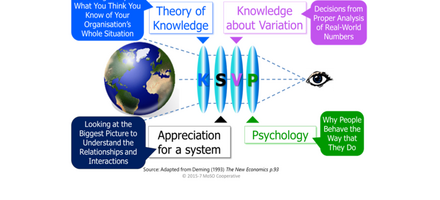
How to engage with Human Activity Systems
Progress indicator
Bob Kennedy describes a fresh interpretation of system of profound knowledge that facilitates meaningful engagement with 21st century human activity systems.
We live in a very busy time when everything must be snappy, easily grasped or quickly discarded. What about quality? Well, just click the ‘got it’ box and move on. When have you last had time to read CQI’s definition of quality on its website? When have you last had time to read anything about quality? Hard to believe that a long, long time ago (1980s) thousands of people like you and I attended four-day conferences given by Dr William Edwards Deming to learn about quality.
System of profound knowledge
While those delegates could take the time to learn, they were also very impatient to get results. Deming admonished them for seeking “instant pudding”, blamed them for the demise of the US industry and offered them his remedy for transformation. He called it a system of profound knowledge (SPK).
Who among us today would be brave enough to suggest the application of SPK to someone who turns to us seeking an instant solution to a quality problem? We could expect a hostile reaction and meltdown as they ponder which box to click. What is SPK and how relevant is it to the complex issues that exist in the 21st century?
Don’t even bother to try to explain SPK. It is very relevant but it isn’t packaged in that snappy easily grasped manner mentioned earlier. It’s time to do a bit of repackaging to help us engage with a much more diverse audience than Deming ever had to. The important systems of his day were those in manufacturing – full of processes and machines supported by humans. Today’s systems are generally service related – full of people, interactions and relationships supported by various technologies. These systems are very autonomous and protective. They decide for themselves what to do and how to do it and are not very welcoming to interference from a well-meaning quality professional.
Human activity systems
Twenty-first century systems are human activity systems (HAS). A HAS could be an individual, an interest group, industry or an institution. Fortunately, they all share one attribute with the quality professional: they all want a quality outcome for their endeavours. They will also all agree that a quality outcome is achieved when the right things are done right. Agreement on this definition of quality and its evaluation is ‘stage one’ of repackaging for the sound-bite generation. It also provides the quality professional with the key to unlock any resistance that might be expected from the HAS he/she wishes to engage with.
Once engaged, we can ask: “Who decides what is the right thing to do and how it should be done?” Generally, the system will respond either: “We do!” or “The customer does!” It is then time to burst their bubble and teach them some basics and how to practise excellence.
Excellence
Tell the members of the HAS that a quality outcome is achieved through the practice of excellence. And lead them to its comprehensive definition and acceptance by presenting it in bite-size, easily grasped and non-contentious stages.
This can be achieved by asking a set of questions and providing the answers. For example:
Q1: What are the stages in delivering a quality outcome?
A1: We must define what is expected. Realise this, deliver it and evaluate the whole experience.
Q2: Who should do this?
A2: We (creators) should do this in agreement with the end user (consumers) and any relevant third parties, such as regulators (complementors). These actors can be termed creators, consumers and complementors, respectively. We need to include all three categories of clients of the system.
Q3: How should we do this?
A3 Through dialogue and agreement, appreciating that things are constantly changing/emerging.
Q4: What core values should guide us?
A4: We should complete these tasks in an enlightened, effective, efficient, ethical, elegant and enjoyable manner.
Now we are ready to give them the definition of ‘excellence’, the pathway or methodology for achieving a quality outcome. A note of caution here: this definition isn’t bite-size, so if you haven’t done a good job leading the HAS through questions one to four, you can expect rolling eyes and evaporation of your audience.
Excellence is an evolving methodology through which a quality outcome is achieved. It is based on voluntary ongoing dialogue and agreement between the creators, consumers and complementors in the system, who define, realise, deliver and evaluate dynamic emerging expectations in an enlightened, effective, efficient, ethical, elegant and enjoyable manner.
Please pause for a moment and reflect on this definition of excellence. Some will remark “That’s everything” as if to dismiss it. They are missing the point. It is intended to be everything that is important in achieving a quality outcome. If not, it wouldn’t be successful.
Q: How do we achieve quality healthcare?
A: By practising excellence.
Q: How do we successfully outsource this process?
A: By practising excellence.
Q: How do I successfully roll-out Lean Six Sigma?
A: By practising excellence.
Three very different contexts that all have the same solution allowing the quality professional to engage.
Here we have reduced Deming’s “By what method?” to an easily grasped concept.
A quality outcome is achieved through the practice of excellence.
Next, we must embrace this practice and help the members of the HAS understand and practise it, as they develop an appreciation for themselves as a system, and determine if it is fit for the purpose intended.
Returning to the HAS
Excellence is useless as a noble intention. It needs a fit-for-purpose system to flesh it out, put it into practice and learn how it works.
It’s time to revamp our sound bite for achieving a quality outcome that includes the system itself:
A quality outcome is achieved by having a system in place that is fit-for-purpose and ensuring it practises excellence.
We are now back to one of the fundamental challenges of SPK, namely: we must have ‘appreciation for a system’.
What a fit-for-purpose HAS looks like is another story for another day.
Meanwhile, we know what excellence is, so let’s start practising it and helping all who engage with us to release its full potential.
Bio: Bob Kennedy PhD is a retired Quality Management Lecturer
Quality World

Get the latest news, interviews and features on quality in our industry leading magazine.


